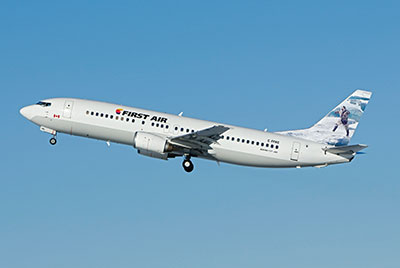
Features
Commercial
At the gate: Joining forces in the North
Talks are continuing on a possible merger between First Air and Canadian North, the two major players in Canada’s north.
September 8, 2014 By Brian Dunn
Talks are continuing on a possible merger between First Air and Canadian North, the two major players in Canada’s north.
 |
|
| We anticipate most employee coverages will either be taken up by natural attrition and/or growth. Photo: First Air
|
First Air is a subsidiary of the Makivik Corporation, founded in 1975 to administer funds paid to the Inuit of Northern Quebec as part of the James Bay Hydro Agreement with the Quebec government. NorTerra, a subsidiary of the Inuvialuit Development Corporation, which represents the Inuit of the Western Arctic, owns Canadian North.
“It was felt there was significant value in exploring the benefits of a merged airline entity that combined the strengths and identities of Canada’s largest northern airlines to provide better, more sustainable airline services for our northern customers,” said Peter McCart, Vice-President, Passenger Sales & Marketing at Canadian North. “Further . . . it was well understood that, in order to grow and develop, change is needed.” First Air would not comment during the negotiations.
Based out of Yellowknife and Iqaluit, First Air has been in business for more than 65 years and operates a fleet of 23 aircraft, including the only two civilian-owned and operated Hercules cargo aircraft in Canada. In addition to the Hercules, the fleet consists of a Boeing 737-400 all passenger aircraft, two 737-400 combis, three 737-200 combis, three 737-200 all passenger aircraft, one 767-223 Super Freighter, nine ATR 42s, and seven ATR 72s.
Its scheduled service carries approximately 225,000 passengers and more than 22 million kilograms of freight and mail over its vast and comprehensive route system, which connects 30 northern communities with Ottawa, Montreal, Winnipeg and Edmonton. It has around 1,000 employees with close to half of them working in the north.
Canadian North has been around for more than 80 years. It was created from Canadian Airlines, Pacific Western Airlines, Transair and Nordair and is based in Yellowknife. It also has about 1,000 employees and serves 19 communities, including Edmonton and Ottawa. It operates a fleet of eight Boeing 737-300s, seven 737-200 Combis and four Dash 8 aircraft. First Air also serves most of the destinations served by Canadian North, so a merger would eliminate a lot of duplication.
But a combined airline should not result in major layoffs or the sale of any aircraft, according to McCart.
“Overall, we don’t anticipate large-scale layoffs or selling of aircraft as the charter business at Canadian North is growing, with fleet renewal plans at both airlines already underway,” he said.
Asked if some routes will be dropped or frequencies adjusted on certain pairings, McCart said there will be an opportunity to review new routes and existing offerings under a merged airline that wouldn’t be possible as competitors. He added that several economies of scale are expected to be achieved.
“Overall, the objective will be to improve the flight network from both a connectivity and community schedule perspective. Improvement in flight schedules to northern communities with better connections to northern hubs would be a key benefit for the merged airline. Today, in several instances, the two airlines combine to serve a community with four flights a day with two flights arriving at almost exactly the same time in the morning and two flights arriving at the same time in the afternoon – all less than half full. This situation could be improved for both communities.”
It’s a very thin market for two airlines to serve, agreed Barry Prentice, Professor of Supply Chain Management, at the I.H. Asper School of Business, University of Manitoba and the former Director of the Transport Institute. “But it’s essential not only for the transportation of people, but also for the food supply, since 80 per cent of what’s consumed in the north must be imported at very high cost.”
Usually, when a competitor exits a market, ticket prices go up, but Prentice doesn’t think it will happen if the two carriers merge, as prices are already high. In fact, prices could come down as a lot of duplication of services will be eliminated, resulting in some job losses.
“That’s one of the reasons for a merger, to bring costs down. You’re not going to have two presidents, two vice-presidents, two maintenance bases and so on. Another issue is whether the merged airline will maintain service and capacity if they don’t have to as a monopoly,” he said.
One major stumbling block to a merger is that the Competition Bureau could step in, suggested Prentice which would not be such a good idea.
“Blocking the merger would limit the potential of one of the airlines, as one will eventually flounder,” Prentice said. “But very few mergers live up to their expectations and there could be friction between the two different corporate cultures. It took Air Canada more than 10 years to absorb Canadian Airlines with their different cultures and pilot seniority squabbles among other issues.”
Brian Dunn is a Wings writer and columnist.